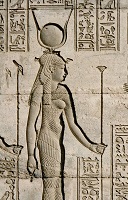 The goddess Hathor was believed to be the mother of the king, who was the living Horus. The name of the goddess, meaning "House of Horus" makes this clear. But she could also give birth to the sun god, a role she took from the sky goddess Nut with whom she was often identified; usually she was seen as a cow during this. She was worshipped as "Lady of Life" (stressing her life-giving qualities) in the so-called birth houses (mammisi) of a number of temples.
The goddess Hathor was believed to be the mother of the king, who was the living Horus. The name of the goddess, meaning "House of Horus" makes this clear. But she could also give birth to the sun god, a role she took from the sky goddess Nut with whom she was often identified; usually she was seen as a cow during this. She was worshipped as "Lady of Life" (stressing her life-giving qualities) in the so-called birth houses (mammisi) of a number of temples.
As a goddess who gave life, she was also frequently mentioned and depicted in funerary context, on Book of the Dead papyri and on tomb walls. She also determined the fate of newborn children.
Hathor played a role in various myths, in all kinds of roles. As mother goddess she was of course associated with Isis (in fact she gave her cow’s horns to Isis). But she was also linked to Sekhmet, Bastet, Wadjet, Nekhbet, Maat, Sopdet, Tefnut and others. Many of these goddesses could appear as a fierce lioness. This fearsome aspect of Hathor was especially stressed in one of the versions of the myth of the sun god’s eye: when Hathor was sent to exterminate mankind, she could not stop killing until Re devised a plan: she was pacified by mixing beer with red ochre, so that it looked like blood; when Hathor had drunk this she was intoxicated and gave up her plan to kill everyone.
Hathor was usually portrayed as a woman with on her head a sun disk between the horns of a cow. She could also be depicted entirely as a cow, or as a lioness. Only her head is frequently shown en face, with cow’s ears, on the top of columns in temples and as the top of the handle of a sistrum (Hathor also being associated with music).
She was worshipped throughout Egypt and beyond (especially the Sinai, where she was known as "Lady of Turquoise" because of her role for the turquoise mines there). Her most important temple was in Dendera.
